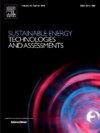400 W facility of geothermal thermoelectric generators from hot dry rocks on the Canary Islands
IF 7
2区 工程技术
Q1 ENERGY & FUELS
Sustainable Energy Technologies and Assessments
Pub Date : 2025-05-12
DOI:10.1016/j.seta.2025.104338
引用次数: 0
Abstract
Geothermal energy has a great potential to be harnessed and requires a boost in technologies to enhance its use. The Canary Islands have a great dependence on fossil fuels, and Lanzarote has important geothermal anomalies currently unexploited due to the absence of water in the soil, what hinders the use of vapour turbines. This work presents the development of the first facility of geothermal thermoelectric generators operating in the world. This novel generators are producing 400 W of power in Timanfaya National Park. It has three geothermal thermoelectric generators, each with 4 thermosyphons per borehole and 40 thermoelectric modules that directly transform heat into electricity. This facility, with the advantages of geothermal energy such as continuity and independence on the weather, requires low maintenance because it does not require moving parts nor water consumption. That makes feasible for the first time to harness the geothermal potential in Lanzarote, producing an electric energy of 9.4 kWh per day, which means 3.42 MWh per year. The field installation of this novel technology has enabled to accurately calculate the Levelized Cost of Energy, which is 0.22 €/kWh. Although a 29% decrease in the power generated by thermoelectric module was detected when installing a GTEG with 40 modules with respect to a GTEG with 10 modules, this decrease is compensated by the fact that by installing more modules, the electrical production per borehole is optimized, reducing the LCOE. The developed facility will avoid the emission of 2.3 tons of CO and is totally respectful with the environment if compared to conventional geothermal power plants.
400瓦的地热发电设备,来自加那利群岛的干热岩石
地热能有很大的利用潜力,需要提高技术以加强其利用。加那利群岛非常依赖化石燃料,兰萨罗特岛有重要的地热异常,目前尚未开发,因为土壤中缺乏水,这阻碍了蒸汽涡轮机的使用。这项工作介绍了世界上第一个地热热电发电机设备的发展。这种新型发电机正在提曼法亚国家公园生产400瓦的电力。它有三个地热热电发电机,每个钻孔有4个热虹吸管和40个热电模块,直接将热量转化为电能。该设施具有地热能的连续性和不受天气影响等优点,不需要移动部件,也不需要消耗水,因此维护成本低。这使得利用兰萨罗特岛的地热潜力首次成为可能,每天产生9.4千瓦时的电能,这意味着每年3.42兆瓦时。这种新技术的现场安装能够准确计算能源的平准化成本,即0.22欧元/千瓦时。尽管与安装10个模块的GTEG相比,安装40个模块的GTEG产生的热电模块功率降低了29%,但通过安装更多模块,可以优化每井眼的发电量,从而降低LCOE,从而弥补了这一减少。与传统地热发电厂相比,该设施将减少2.3吨二氧化碳的排放,完全尊重环境。
本文章由计算机程序翻译,如有差异,请以英文原文为准。
求助全文
约1分钟内获得全文
求助全文
来源期刊

Sustainable Energy Technologies and Assessments
Energy-Renewable Energy, Sustainability and the Environment
CiteScore
12.70
自引率
12.50%
发文量
1091
期刊介绍:
Encouraging a transition to a sustainable energy future is imperative for our world. Technologies that enable this shift in various sectors like transportation, heating, and power systems are of utmost importance. Sustainable Energy Technologies and Assessments welcomes papers focusing on a range of aspects and levels of technological advancements in energy generation and utilization. The aim is to reduce the negative environmental impact associated with energy production and consumption, spanning from laboratory experiments to real-world applications in the commercial sector.
 求助内容:
求助内容: 应助结果提醒方式:
应助结果提醒方式:


